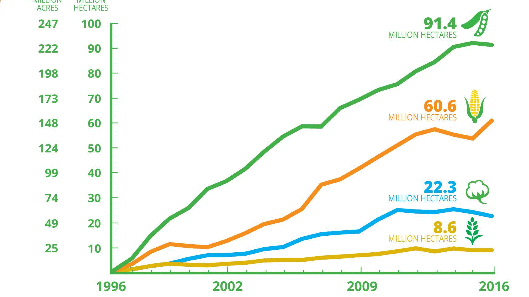GMO acreage growing – GMO acreage - Arhive
GMO acreage
“Biotech crops have become a vital agricultural resource for farmers around the world because of the immense benefits for improved productivity and profitability, as well as conservation efforts,” said Paul Teng, Cair of the Board of the International Service for the Acquisition of Agri-biotech Applications (ISAAA), who published the annual GMO statistics. Whilst adoption in the US, the Americas and Asia, was high, Europe and Africa are still lagging behind.GMO acreage
In Europe, resistance against GMO products remained high. Only four countries – Spain (129,081 ha), Portugal (7,069 ha), Slovakia (138 hy) and the Czech Republic (75 ha) planted GMO crops.GMO acreage
Efforts by the European Commission to accelerate GMO market approval of safety assessed GMOs by granting member states the right to opt out from acreage had failed in late March: Applications for market approval of three GM maize crops (Syngenta’s Bt11 maize, Dow Agrosciences’ GM Maize 1507, and BASF/Monsantos’s Mon810 maize) to be cultivated in the EU failed because EU countries did not change their voting behaviour. They did not reach a qualified majority pro or against the insect resistant crops.
ISAAA reported that the adoption of biotech crops has reduced CO2 emissions equal to removing 12 million cars from the road annually in recent years; and that it has contributed to a 19% reduction in herbicide and insecticide use.GMO acreage
In 2016, the leading countries growing biotech crops included the US, Brazil, Argentina, Canada and India. Combined, these five countries planted 91% of the global biotech crop area. In 2016, Brazil, global No. 2 behing the US regarding GMO cultivation area, increased acreage of GM maize, soybean, cotton and canola by a remarkable 11%. Biotech soybeans grown in Brazil accounted for 32.7m ha of the 91.4m ha grown worldwide. Biotech soybean varieties accounted for 50% of global biotech crop area. Based on global area for individual crops, 78% of soybean, 64% of cotton, 26% of maize and 24% of canola planted in the world were biotech varieties.GMO acreage
As biotech crops enter the third decade of planting/commercialization, the ISAAA project game changing innovations can double food production. Genome editing and new breeding technologies have already entered the market. And health-improving products of soybean for humans and animals (omega-3 fatty acids, high oleic acid, low phytate, and high stearic acid), modified starch/sugar (potato), low-lignin (alfalfa), non-browning potatoes are already available; non-browning apples projected to be available in the US market in 2017; as well as beta-carotene and ferritin in major staple crops which are already in the advanced stages of development. Innate™ potato series have been commercialized in the US, with 2,500 hectares of potatoes and 70,000 non-browning apple trees (~81 hectares). Acceptance of these two biotech crops can contribute in the reduction of food waste due to browning and easy spoilage of products, the ISAAA reported.

